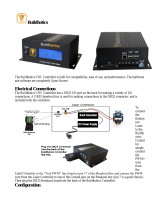
Turbo PMAC2 PCI Hardware Reference Manual
Table of Contents i
Table of Contents
INTRODUCTION.......................................................................................................................................................1
Board Configuration.................................................................................................................................................1
Base Version ........................................................................................................................................................1
Option 1: Additional Four Channels Axis Interface Circuitry............................................................................1
Option 2: Dual-Ported RAM...............................................................................................................................1
Option 5: CPU and Memory Configurations......................................................................................................2
Option 7: Plate Mounting ...................................................................................................................................2
Option 8: High-Accuracy Clock Crystal.............................................................................................................3
Option 9: Serial Port Configuration...................................................................................................................3
Option 10: Firmware Version Specification .......................................................................................................3
Option 12: Analog-to-Digital Converters...........................................................................................................3
Option 16: Battery-Backed Parameter Memory .................................................................................................3
Option 18: Identification Number and Real Time Clock/Calendar Module .......................................................3
HARDWARE SETUP.................................................................................................................................................5
Piggyback Turbo CPU Board Jumper Configuration ...............................................................................................5
Watchdog Timer Jumper......................................................................................................................................5
Dual-Ported RAM Source Jumper .......................................................................................................................5
Power-Up State Jumpers......................................................................................................................................5
Firmware Load Jumper........................................................................................................................................5
Base Board Jumper Configuration............................................................................................................................5
Servo and Phase Clock Direction Control...........................................................................................................5
Re-Initialization Jumper.......................................................................................................................................6
Encoder Sample Clock Source Jumpers...............................................................................................................6
Serial Port Selection Jumper................................................................................................................................6
Output Disable State Jumpers..............................................................................................................................6
Resistor Pack Configuration.....................................................................................................................................6
Termination Resistors ..........................................................................................................................................6
Pull-Up/Pull-Down Resistors...............................................................................................................................7
Connections..............................................................................................................................................................7
Mounting..............................................................................................................................................................7
Power Supply Connection....................................................................................................................................8
Machine Port Connections...................................................................................................................................8
Display Port.........................................................................................................................................................8
Multiplexer Port...................................................................................................................................................8
I/O Port................................................................................................................................................................8
Serial Ports ..........................................................................................................................................................9
A/D-Converter Port..............................................................................................................................................9
Handwheel Port ...................................................................................................................................................9
COMMUNICATIONS SETUP ................................................................................................................................11
CPU BOARD E-POINT DESCRIPTIONS.............................................................................................................13
E1: Watchdog Disable Jumper ...............................................................................................................................13
E2: DPRAM Location Configure ...........................................................................................................................13
E4 – E6: Power-Up/Reset Load Source..................................................................................................................13
E7: Firmware Reload Enable..................................................................................................................................13
BASE BOARD JUMPER DESCRIPTIONS...........................................................................................................15
E1: Servo and Phase Clock Direction Control.......................................................................................................15
E2: CPU Frequency Select ....................................................................................................................................15
E3: Normal/Re-Initializing Power-Up/Reset.........................................................................................................15
E4: CPU Frequency Select .....................................................................................................................................15
E5 – E6: (Reserved for Future Use).......................................................................................................................15
E13 - E14: Encoder Sample Clock Direction Control...........................................................................................16























